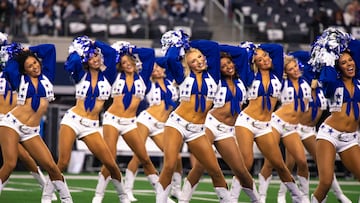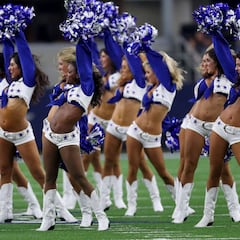Netflix’s “America’s Sweetheart” docu-series exposes horrors faced by Dallas Cowboys cheerleaders
Considering the high standards the Dallas Cowboys cheerleaders are expected to uphold, it’s no surprise that their low pay grade has shocked the world.


Netflix released its new documentary series, “America’s Sweethearts: Dallas Cowboys Cheerleaders” on Thursday, and it has since sparked outrage across the nation, and for good reason. The series follows the intense and difficult audition process to become a Dallas Cowboys cheerleader as well as some of the lives of the girls trying out for the squad.
The show gives us insight into some of the horrors that come with being the picture-perfect “America’s Sweetheart”. The expectations to be perfect both aesthetically and athletically have caused many of the women involved to form eating disorders and mental health issues. Four-year veteran Victoria Kalina opens up about her anxiety, depression, and eating disorder that were all amplified during her time with the DCC.
“It’s a binge to get that feel-good, that empty feeling filled again, but then game time comes, so then you just gotta get into those baby clothes, get into that baby uniform and that cycle just keeps going,” Kalina said.
The DCC’s shockingly low pay for shockingly high expectations
One important thing to note about NFL cheerleaders is that, unlike the NFL players, the cheerleaders are not unionized and have no governing body at all. Many teams consider the cheerleaders to be independent contractors and are therefore not given access to mental health professionals, nutritionists, or really any support beyond each other.
With that in mind, they have no one to fight for fair pay but themselves. In comparison to an NFL player, the cheerleaders make pennies. They even make less than the waterboys. Until 2018, when one single DCC came forward to fight for an increased wage for the cheerleaders, the DCC made only $200 a game. Erica Wilkins sued the organization, stating that the cheerleaders make even less than the mascot and were paid below the minimum wage. The Cowboys settled out and raised the gameday pay to $400, and according to one anonymous cheerleader who spoke to HuffPost, they make around $12.50 per hour. However, the hourly rates are not made public.
Most of the girls on the squad have either part-time or full-time jobs during the day before spending nearly all their extra time being a DCC. The Netflix series follows some of the girls at home and at their jobs, which include a nurse and orthodontist. DCC Kelcey Wetterberg reveals in the show that she works from 7 in the morning until 4:30 in the afternoon, and then spends her nights at practice, getting an average of 5 hours of sleep.
Cowboys cheerleaders are expected to put their physical and mental health on the lines, sacrifice their nights and weekends, smile through the pain and look perfect while doing it, in exchange for “sisterhood”.
The issue of pay is unfortunately glossed over in the documentary. It is discussed in the first episode, when former cheerleader Kat Puryear compares her wage to that of a full-time Chick-fil-A employee, and then never discussed again as an ongoing issue, though it certainly seems to be one. The organization defends itself by referring to the status of a Dallas Cowboys cheerleader as a privilege.
“There’s a lot of cynicism around pay for NFL cheerleaders, and as it should be,” Dallas Cowboys chief brand officer Charlotte Jones says in the series. “They’re not paid a lot. But the facts are that they actually don’t come here for the money. They come here for something that’s actually bigger than that to them.”
They argue that the connections and experience gained while being a part of the DCC are worth more than any payment. Meanwhile, the girls are not allowed to have any sponsorship deals or sign with social media agencies, and have limited opportunities to earn money as a cheerleader. They are expected to show up on time, looking perfect, make zero mistakes at any given time, never complain, make other people happy, and smile, smile, smile.
“It’s kind of a running joke for the girls on the team,” explained the HuffPost’s anonymous source. “The guys on the practice squad, who don’t even touch the field half of the time, getting 80 grand more than we do a year. And I’m at every single game, dancing my ass off, and every other appearance, and my face is all over The Star. You don’t even know who these guys on the practice team are.”
Related stories
“It’s unfortunate that with how much they pretend or say that we are important and the face of the organization, the way they treat us and pay us does not come near to equal that.”
As the Netflix series has brought this and other issues to light (albeit only on the surface level), the reactions have been that of shock and outrage.
The most infuriating thing about the Dallas Cowboy Cheerleaders documentary isn't the ridiculous beauty standards, it's the fact they pay them a pittance so they have to work second jobs, while the footballers are paid millions. The women are just as much athletes as the men.
— Catherine Lux (@luxlifeblog) June 20, 2024
Wonder how much he owner of the Dallas Cowboys cheerleaders makes. Or does she just do it for the privilege and the sisterhood? The cheerleaders work their asses off for everyone else to make their millions. Gross. #dcc #netflix #cheerleaders
— Sneha Mistri (@SnehaMISTRI) June 20, 2024
The fact that @dallascowboys is one of the most profitable NFL teams but pays their cheerleaders as much as a fast-food worker is crazy #americassweethearts
— Jireh Tumba (@jireh_tumba) June 20, 2024


Complete your personal details to comment